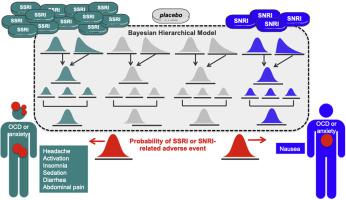Journal of the American Academy of Child and Adolescent Psychiatry ( IF 9.2 ) Pub Date : 2019-11-01 , DOI: 10.1016/j.jaac.2019.10.013 Jeffrey A Mills 1 , Jeffrey R Strawn 2

|
Objective
To compare adverse events (AEs), suicidality, and AE-related discontinuation in double-blind, placebo-controlled trials of pediatric patients with obsessive-compulsive disorder (OCD) and anxiety disorders treated with selective serotonin reuptake inhibitors (SSRIs) or serotonin-norepinephrine reuptake inhibitors (SNRIs).
Method
MEDLINE, PubMed, Web of Science, PsycINFO, and Embase were searched for peer-reviewed, English-language articles from inception through March 1, 2019. We identified prospective, randomized SSRI and SNRI studies in patients <18 years of age with OCD or generalized, separation, or social anxiety disorders. AE rates were extracted and medication-placebo differences were examined using Bayesian hierarchical models, then posterior estimates of relative risk (RR) were determined for each AE by medication class and disorder.
Results
Data were included from 18 trials (2,631 patients) and 7 medications (16 SSRI and 4 SNRI trials). Compared with placebo, SSRIs were associated with a greater likelihood of AE-related discontinuation (RR 3.59, credible interval [CrI] 0.019–0.067, p = .0003), activation (RR 2.39, CrI 0.048–0.125, p = .003), sedation (RR 1.94, CrI 0.035–0.157, p = .002), insomnia (RR 1.93, CrI 0.040–0.149, p = .001), abdominal pain (RR 1.53, CrI 0.032–0.164, p = .005), and headache (RR 1.24, CrI 0.003–0.139, p = .04). Activation was more common with SSRIs (versus SNRIs, RR 1.32, CrI 0.018–0.114, p = .007). Neither SSRIs nor SNRIs were associated with treatment-emergent suicidality.
Conclusion
In pediatric OCD and anxiety disorders, SSRIs (compared with placebo) are associated with distinct AEs and greater AE-related discontinuation, although their tolerability does not differ between anxiety disorders and OCD. Compared with SNRIs, SSRIs are more likely to produce activation. Class-related AEs are important for clinicians to consider, particularly in light of data suggesting differences in class-related efficacy. Whereas SSRIs are superior to SNRIs and the treatment of choice for anxiety, for youths who become activated on SSRIs, SNRIs might represent a good second choice given their reported efficacy and lower risk of activation.
中文翻译:

儿科焦虑和强迫症的抗抑郁药物耐受性:贝叶斯分层建模荟萃分析
客观的
旨在比较使用选择性血清素再摄取抑制剂 (SSRIs) 或血清素治疗的强迫症 (OCD) 和焦虑症儿科患者的双盲、安慰剂对照试验中的不良事件 (AE)、自杀和 AE 相关的停药。去甲肾上腺素再摄取抑制剂(SNRI)。
方法
在 MEDLINE、PubMed、Web of Science、PsycINFO 和 Embase 上搜索了从开始到 2019 年 3 月 1 日的同行评审英文文章。我们确定了针对 18 岁以下强迫症或强迫症患者的前瞻性、随机 SSRI 和 SNRI 研究。普遍性、分离性或社交焦虑症。提取 AE 发生率,并使用贝叶斯分层模型检查药物与安慰剂的差异,然后根据药物类别和疾病确定每种 AE 的相对风险 (RR) 的后验估计。
结果
数据来自 18 项试验(2,631 名患者)和 7 种药物(16 项 SSRI 试验和 4 项 SNRI 试验)。与安慰剂相比,SSRIs 与 AE 相关的停药(RR 3.59,可信区间 [CrI] 0.019-0.067, p = .0003)、激活(RR 2.39,CrI 0.048-0.125, p = .003)的可能性更大、镇静(RR 1.94,CrI 0.035–0.157, p = .002)、失眠(RR 1.93,CrI 0.040–0.149, p = .001)、腹痛(RR 1.53,CrI 0.032–0.164, p = .005),和头痛(RR 1.24,CrI 0.003–0.139, p = .04)。 SSRI 的激活更为常见(相对于 SNRI,RR 1.32,CrI 0.018–0.114, p = .007)。 SSRIs 和 SNRIs 均与治疗引起的自杀无关。
结论
在儿科强迫症和焦虑症中,SSRIs(与安慰剂相比)与不同的 AE 和更大的 AE 相关停药相关,尽管它们的耐受性在焦虑症和强迫症之间没有差异。与SNRIs相比,SSRIs更容易产生激活作用。类别相关的 AE 对于临床医生来说很重要,特别是考虑到数据表明类别相关的疗效存在差异。尽管 SSRIs 优于 SNRIs,也是治疗焦虑症的首选药物,但对于服用 SSRIs 的年轻人来说,SNRIs 可能是一个很好的第二选择,因为其报道的疗效和较低的激活风险。









































 京公网安备 11010802027423号
京公网安备 11010802027423号